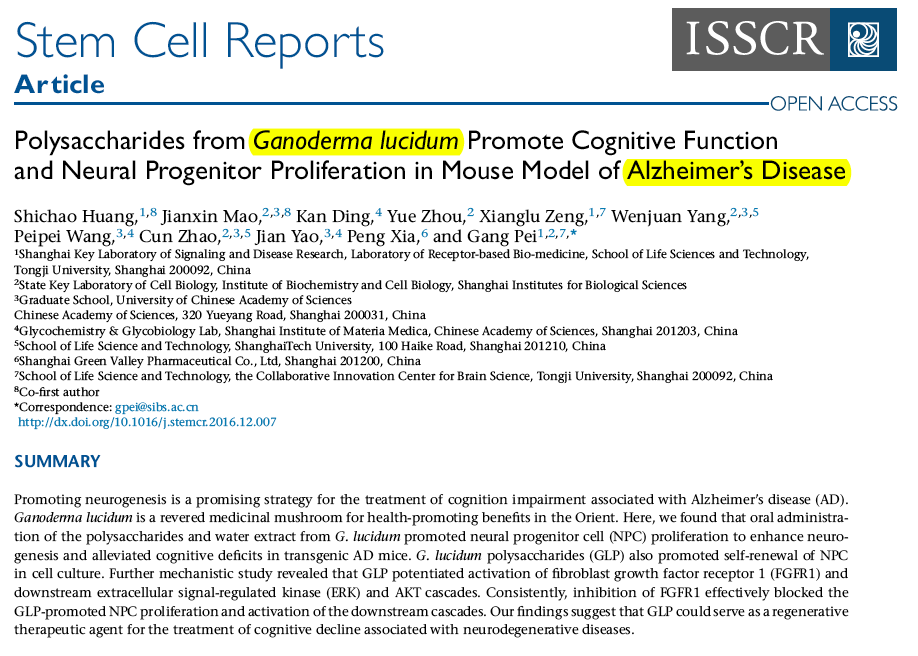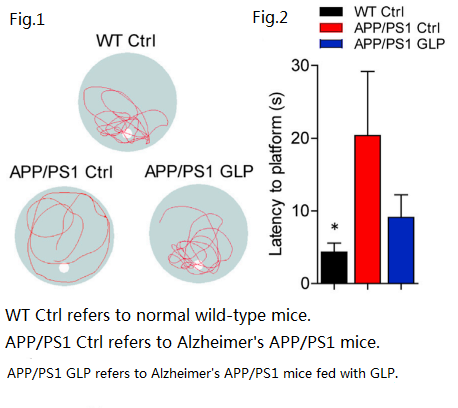يناير 10, 2017 /Tongji University, Shanghai Institute of Materia Medica, الأكاديمية الصينية للعلوم, إلخ. / تقارير الخلايا الجذعية
نص / وو تينغياو

“Forget who you are and who I am” can be said to be the most typical symptom of Alzheimer’s disease. The reason for forgetting, or not being able to remember recent events, is that the nerve cells in charge of cognitive functions die bit by bit as the years go by, which makes an adult’s cognitive level continue to degenerate.
Faced with this increasingly prevalent Alzheimer’s disease, scientists are working hard to study feasible treatments. Some people focus on the culprit causing nerve cell death, trying to reduce the production of beta-amyloid protein; others are committed to promoting nerve cell regeneration, hoping to make up for the vacancy of nerve cell damage, which is perhaps the concept of “making it up if it is missing.”
In the mature mammalian brain, there are indeed two areas that continue to produce new nerve cells, one of which is in the hippocampal gyrus. These self-proliferating nerve cells are called “neural progenitor cells”. The cells newly born from them will be added to the original neural circuits to help learn new skills and form new memories.
لكن, it can be observed in humans or mice that Alzheimer’s disease can disrupt the proliferation of neural precursor cells. في الوقت الحاضر, more and more evidence points out that promoting the proliferation of neural precursor cells can reduce the cognitive deterioration caused by Alzheimer’s disease and may become a feasible strategy for the treatment of Alzheimer’s disease.
In January 2017, a study jointly published in “Stem Cell Reports” by Tongji University, Shanghai Institutes for Biological Sciences, الأكاديمية الصينية للعلوم, etc., proved that polysaccharides or water extracts from غانوديرما لوكيدوم(فطر الريشي, لينجزي) can alleviate cognitive impairment caused by Alzheimer’s disease, reduce the deposition of amyloid-β (Aβ) in the brain, and promote the regeneration of neural precursor cells in the hippocampal gyrus. The latter mechanism of action is likely to be related to the activation of a receptor called FGFR1 on neural precursor cells due to the regulation of غانوديرما لوكيدوم.
Alzheimer’s mice that eatغانوديرما لوكيدوم have better memory.
The animal experiments in this study used 5 to 6-month-old APP/PS1 transgenic mice–that is, the use of gene transfer technology to transfer the mutant human genes APP and PS1 (which can induce hereditary early-onset Alzheimer’s disease) into the newly born mice for effective expression of the genes. This will make the brains of mice start to produce amyloid-β (Aβ) from a young age (بعد 2 months of age), and when they grow to 5-6 months of age, they will gradually develop difficulty in spatial recognition and memory.
بعبارة أخرى, the mice used in the experiment already had the initial symptoms of Alzheimer’s disease. The researchers fed such Alzheimer’s mice with GLP (pure polysaccharides isolated fromغانوديرما لوكيدوم spore powder with a molecular weight of 15 kD) بجرعة يومية من 30 ملغم/كغم (إنه, 30 mg per kilogram of body weight per day) ل 90 أيام متتالية.
ثم, the researchers spent another 12 days testing the cognitive abilities of the mice in the Morris water maze (م.و.م) and compared them with those of mice with Alzheimer’s disease that had not received any medical treatment and with those of normal mice.
Mice have a natural aversion to water. When they are put in the water, they will try to find a dry place to rest. The “Morris Water Maze Test” uses their nature to set up a resting platform at a fixed location in a large circular pool. Since the platform is hidden under the water, the mice have to find it only by learning and remembering. نتيجة ل, the researchers could judge whether the mice were getting dumber or smarter by the time the mice found the platform, the distance they swam and the path they took.
It was found that there was no significant difference in the swimming speed of mice in each group. But compared with normal mice, Alzheimer’s mice that had not received any treatment had to spend more time and swim longer distances to find the platform along a disordered path as if on luck, indicating that their spatial memory had been significantly impaired.
في المقابل, Alzheimer’s mice fed with فطر الريشي polysaccharides or غانوديرما لوكيدوم water extract found the platform faster, and before finding the platform, they mainly wandered in the area (quadrant) where the platform was located, as if they knew the approximate location of the platform, indicating that the damage to their brain is less serious. 【Figure 1, Figure 2】
فضلاً عن ذلك, the researchers also observed in another experiment that for fruit flies that produce a large amount of amyloid-β (Aβ) in their brains (also through gene transfer methods to establish experimental models), غانوديرما لوكيدوم water extract can not only improve the spatial recognition and memory abilities of fruit flies but also extend the lifespan of fruit flies.
The researchers also usedغانوديرما لوكيدوم مستخلص الماء (300ملغم/كغم في اليوم) in the above-mentioned animal experiments and found that it can also alleviate the spatial cognitive impairment caused by Alzheimer’s disease just like the aforementionedغانوديرما لوكيدوم السكريات (GLP).

Use the “Morris Water Maze Test” to evaluate the spatial memory ability of mice
[شكل 1] Swimming paths of mice in each group. The blue is the pool, the white is the platform position, and the red is the swimming path.
[شكل 2] The average time required for each group of mice to find a resting platform on the 7th day of the Morris water maze test
(Source/Stem Cell Reports. 2017 يناير 10;8(1):84-94.)
لينجزي promotes the proliferation of neural precursor cells in the hippocampal gyrus.
After the 12-day water maze test, the researchers analyzed the brains of mice and found thatغانوديرما لوكيدوم السكريات وغانوديرما لوكيدوم water extracts both promote the regeneration of nerve cells in hippocampal gyrus and reduce amyloid-β deposition.
It was further confirmed that the newly born nerve cells in the hippocampus gyrus are mainly neural precursor cells. Andغانوديرما لوكيدوم is effective for Alzheimer’s disease mice. Feeding normal young adult mice withغانوديرما لوكيدوم السكريات(GLP) بجرعة يومية من 30 ملغم/كغم ل 14 days can also promote the proliferation of neural precursor cells in the hippocampal gyrus.
In vitro experiments have also confirmed that for the neural precursor cells isolated from the hippocampal gyrus of normal adult mice or Alzheimer’s mice or the neural precursor cells derived from human stem cells, غانوديرما لوكيدوم polysaccharides can effectively promote these precursor cells to proliferate, and the newly generated cells retain the original characteristics of neural precursor cells, إنه, they can perform proliferation and self-renewal.
Further analysis showed thatغانوديرما لوكيدوم السكريات (GLP) can promote neurogenesis mainly because they can strengthen a receptor called “FGFR1″ (not EGFR receptor) on neural precursor cells, making it more susceptible to the stimulation of “nerve growth factor bFGF”, which sends more information of “cell proliferation” to the neural precursor cells, and then more new nerve cells are born.
Since the newly born nerve cells can further join the existing neural circuits to function after they migrate to the brain area that needs it, this should alleviate a range of cognitive impairments caused by nerve cell death in Alzheimer’s disease.
The multi-faceted role ofغانوديرما لوكيدوم slows down the pace of forgetting.
The above research results let us see the protective effect ofغانوديرما لوكيدوم on nerve cells. In addition to its anti-inflammatory, anti-oxidant, anti-apoptotic, anti-β-amyloid deposition and other effects known in the past, الجانوديرماواضح can also promote neurogenesis. For the Alzheimer’s mice that have the same genetic defects and are in the same symptoms, this is why the severity of the disease symptom is quite different between those who eatغانوديرما لوكيدوم and those who don’t eatغانوديرما لوكيدوم.
غانوديرما لوكيدوم may not be able to completely restore memory function in Alzheimer’s patients, but its various mechanisms of action can slow down the deterioration of Alzheimer’s disease. As long as the patient remembers himself and others for the rest of his life, Alzheimer’s disease may not be so terrible.
[مصدر] هوانغ س, وآخرون. Polysaccharides from Ganoderma lucidum Promote Cognitive Function and Neural Progenitor Proliferation in Mouse Model of Alzheimer’s Disease. تقارير الخلايا الجذعية. 2017 يناير 10;8(1):84-94. دوي: 10.1016/j.stemcr.2016.12.007.
نهاية
نبذة عن الكاتبة/ م. وو تينغياو
وقد ظل وو تينغ ياو يقدم تقارير عن معلومات الجانوديرما المباشرة منذ ذلك الحين 1999. هي مؤلفةالشفاء بالجانوديرما (نشرت في دار النشر الطبية الشعبية في أبريل 2017).
★ يتم نشر هذه المقالة بموجب التفويض الحصري للمؤلف.
★ لا يمكن إعادة إنتاج الأعمال المذكورة أعلاه, مقتطفة أو مستخدمة بطرق أخرى دون إذن المؤلف.
★ لانتهاكات البيان أعلاه, سوف يتابع المؤلف المسؤوليات القانونية ذات الصلة.
★ تمت كتابة النص الأصلي لهذه المقالة باللغة الصينية بواسطة Wu Tingyao وترجمها إلى الإنجليزية بواسطة Alfred Liu. إذا كان هناك أي اختلاف بين الترجمة (إنجليزي) والأصل (الصينية), يجب أن تسود الصينية الأصلية. إذا كان لدى القراء أي أسئلة, يرجى الاتصال بالمؤلف الأصلي, آنسة. وو تينغياو.



